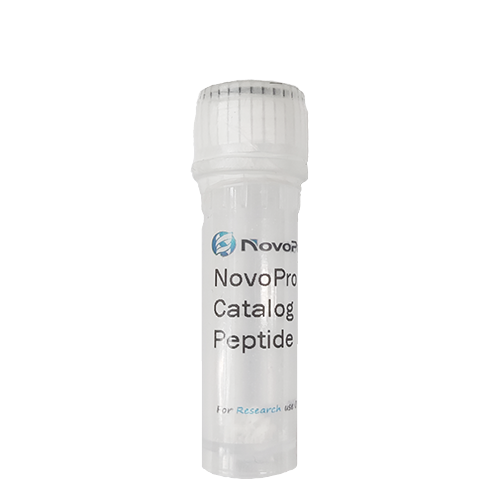CMX-8933 peptide
Not For Human Use, Lab Use Only.
Cat.#: 319738
Special Price 101.70 USD
-
Product Name
CMX-8933 peptide
-
Documents
Batch to batch variation of the purity
-
Sequence Shortening
H-KKETLQFR-OH
-
Sequence
H-Lys-Lys-Glu-Thr-Leu-Gln-Phe-Arg-OH
-
Length (aa)
8
-
Peptide Purity (HPLC)
95.48%
-
Molecular Formula
C47H80N14O13
-
Molecular Weight
1049.22
-
CAS No.
146877-90-9
-
PubChem CID
11457457
-
Source
Synthetic
-
Form
Powder
-
Description
CMX-8933 is an 8-amino acid peptide fragment of Ependymin, a goldfish brain glycoprotein. CMX-8933 has the function of activating the AP-1 transcription factor in both mouse neuroblastoma (NB2a) and primary rat brain cortical cell cultures. In NB2a cells, a 13–14-fold increase in AP-1’s DNA binding was obtained with 6–10 mg/ml CMX-8933 after 4 h incubation, and in primary rat brain cortical cultures, a 26.7 ± 5.2-fold increase in binding was observed with as little as 10 ng/ml peptide after 3 h treatment. The activation of AP-1 transcription factor by CMX-8933 is rapid and transient, and it may play a role in transcriptional control, which is characteristic of full-sized neurotrophic factors in neuronal differentiation and regeneration. This suggests a potential role for Ependymin, from which CMX-8933 is derived, in transcriptional control and neuroplasticity.
-
Storage Guidelines
Normally, this peptide will be delivered in lyophilized form and should be stored in a freezer at or below -20 °C. For more details, please refer to the manual: Handling and Storage of Synthetic Peptides
-
References
- Shashoua VE, Adams D, Boyer-Boiteau A. CMX-8933, a peptide fragment of the glycoprotein ependymin, promotes activation of AP-1 transcription factor in mouse neuroblastoma and rat cortical cell cultures. Neurosci Lett. 2001 Oct 19;312(2):103-7. doi: 10.1016/s0304-3940(01)02119-x. PMID: 11595345.
-
About TFA salt
Trifluoroacetic acid (TFA) is a common counterion from the purification process using High-Performance Liquid Chromatography (HPLC). The presence of TFA can affect the peptide's net weight, appearance, and solubility.
Impact on Net Weight: The TFA salt contributes to the total mass of the product. In most cases, the peptide content constitutes >80% of the total weight, with TFA accounting for the remainder.
Solubility: TFA salts generally enhance the solubility of peptides in aqueous solutions.
In Biological Assays: For most standard in vitro assays, the residual TFA levels do not cause interference. However, for highly sensitive cellular or biochemical studies, please be aware of its presence.
-
Molar Concentration Calculator
-
Dilution Calculator
-
Percent Concentration Calculator
Mass (g) = Concentration (mol/L) × Volume (L) × Molecular Weight (g/mol)
Related Products / Services
• Peptide Services: NovoPro's peptide synthesis services include standard chemical peptide synthesis, peptide modification, peptide libraries, and recombinant peptide expression.
• Standard Peptide Synthesis: NovoPro offers quality peptides at the most competitive prices in the industry, starting at $3.20 per amino acid. NovoPro provides PepBox – Automatic Quote Tool for online price calculation.
• Peptide Modifications: NovoPro offers a wide range of peptide modification services including isotope labeling (2H, 15N, and 13C), multiple disulfide bonds, multiple phosphorylations, KLH, BSA, ovalbumin, amidation, acetylation, biotin, FITC, etc.
Please note: All products are "FOR RESEARCH USE ONLY AND ARE NOT INTENDED FOR DIAGNOSTIC OR THERAPEUTIC USE"

